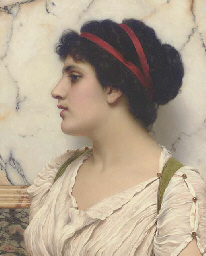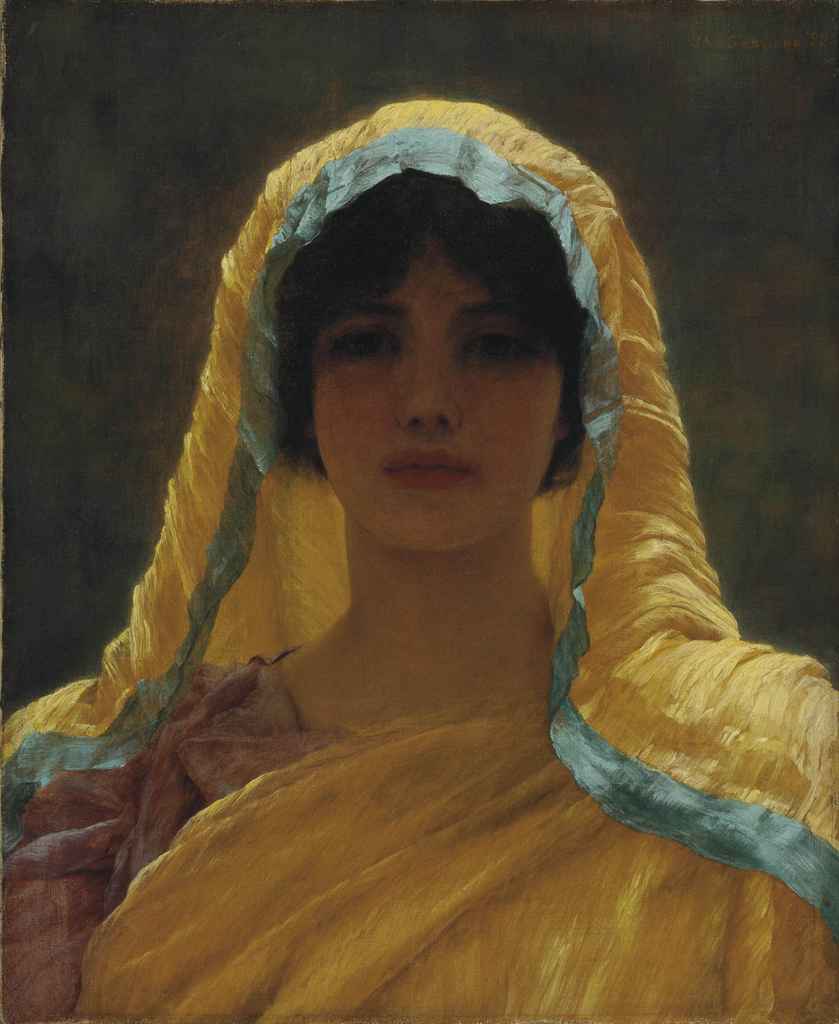JOHN WILLIAM GODWARD (BRITISH 1861-1922) A BIRTHDAY PRESENT Oil on canvas Signed and dated 'J. W. Godward 97' (lower left) 46 x 56cm (18 x 22 in.) Provenance: Messrs. Thomas McLean, London 21 September 1897 Private Collection, UK Literature: McLean letter to Godward (21 Sept 1897) Mio-Turner Collection Swanson, Vern Grosvenor, The Eclipse of Classicism¸ 1997, p.195 Swanson, Vern Grosvenor, The Eclipse of Classicism¸ 2018, p.275 John William Godward (1861-1922) was one of the last of the classical painters of the Victorian age. Slightly younger than his better-known counter parts: Sir Frederic Leighton (1830-1896), Lawrence Alma-Tadema (1836-1912), and John Poynter (1836-1919) he was working in the dawn of a new, modernist era at the end of the 19th century, one which had little place for the Classical ideals of Antiquity which had dominated art for the last 500 years. His career has been described by Swanson as the 'Eclipse of Classicism'. The author goes on to expand that Godward's career 'offers the clearest example of the demise of classical Greco-Roman subject painting' (Swanson, p.8). As a reclusive genius, and someone who almost certainly had Asperger's Syndrome, little is known about Godward's private life. This is partly due to his strict family upbringing and somewhat overbearing mother, Sarah Eboral, who outlived her son by 13 years, dying at the age of 100 in 1932. When Godward moved to Italy with one of his models in 1912, his family broke contact with the artist, destroyed many papers, and removed his image from family pictures. Indeed, only one photo of the artist is thought to exist. Although little is known about the young artist's schooling, as the eldest of five children, by all accounts Godward came from a respectable bourgeois family and ideal Victorian home. It is therefore likely that his family would have been able to afford to send him a private school, as was common for middle class children at that time. What is certain, is that there was pressure for all the Godward children to follow their father's lead into the family profession of insurance, investing and banking. Although his siblings all seem to have succeeded in this expectation, John William did not. Between 1879 and 1881, it is believed Godward studied under the architect William Hoff Wontner (1814 - 1881). This apprenticeship seems the likely source for Godward's ability to render perspective and architectural elements, as well as being able to realistically depict marble and porphyry. It was around this time that Swanson believes Godward turned his aspirations to becoming a fine artist. Whether Godward received any formal art training is purely a matter of speculation as there are no records, but given his family's insistence that he follow in his father's footsteps into the work of business, it seems unlikely that he would have had access to any instructional study. We do know however that by 1881, Wontner had died, and his son William Clarke had taken over the family business. By 1885, Wontner and Godward had become best friends, and the former had taken a post at St. John's Wood Art School. It is perhaps not too much of a leap then, to assume that at least some instruction was taken from his friend. It is most likely that Goward's exposure to specifically Graeco-Roman subject painting came through seeing contemporary work at the Royal Academy or Royal Society of British Artists. In 1887, his own debut work, A Yellow Turban, (No. 721) was accepted into the Royal Academy Summer Exhibition. He continued to exhibit with the Royal Academy until 1905. It was also during 1887, that Godward exhibited for the first time at the RBA, with a painting called Poppaea (No. 401). Three years later, he was officially elected as a member of the organisation. In 1888, Godward exhibited his oil, Ianthe (No. 941), at the Royal Academy. Upon seeing the painting, he was approached by the infamous art dealer Arthur Tooth who asked whether he might include it in
JOHN WILLIAM GODWARD (BRITISH 1861-1922) A BIRTHDAY PRESENT Oil on canvas Signed and dated 'J. W. Godward 97' (lower left) 46 x 56cm (18 x 22 in.) Provenance: Messrs. Thomas McLean, London 21 September 1897 Private Collection, UK Literature: McLean letter to Godward (21 Sept 1897) Mio-Turner Collection Swanson, Vern Grosvenor, The Eclipse of Classicism¸ 1997, p.195 Swanson, Vern Grosvenor, The Eclipse of Classicism¸ 2018, p.275 John William Godward (1861-1922) was one of the last of the classical painters of the Victorian age. Slightly younger than his better-known counter parts: Sir Frederic Leighton (1830-1896), Lawrence Alma-Tadema (1836-1912), and John Poynter (1836-1919) he was working in the dawn of a new, modernist era at the end of the 19th century, one which had little place for the Classical ideals of Antiquity which had dominated art for the last 500 years. His career has been described by Swanson as the 'Eclipse of Classicism'. The author goes on to expand that Godward's career 'offers the clearest example of the demise of classical Greco-Roman subject painting' (Swanson, p.8). As a reclusive genius, and someone who almost certainly had Asperger's Syndrome, little is known about Godward's private life. This is partly due to his strict family upbringing and somewhat overbearing mother, Sarah Eboral, who outlived her son by 13 years, dying at the age of 100 in 1932. When Godward moved to Italy with one of his models in 1912, his family broke contact with the artist, destroyed many papers, and removed his image from family pictures. Indeed, only one photo of the artist is thought to exist. Although little is known about the young artist's schooling, as the eldest of five children, by all accounts Godward came from a respectable bourgeois family and ideal Victorian home. It is therefore likely that his family would have been able to afford to send him a private school, as was common for middle class children at that time. What is certain, is that there was pressure for all the Godward children to follow their father's lead into the family profession of insurance, investing and banking. Although his siblings all seem to have succeeded in this expectation, John William did not. Between 1879 and 1881, it is believed Godward studied under the architect William Hoff Wontner (1814 - 1881). This apprenticeship seems the likely source for Godward's ability to render perspective and architectural elements, as well as being able to realistically depict marble and porphyry. It was around this time that Swanson believes Godward turned his aspirations to becoming a fine artist. Whether Godward received any formal art training is purely a matter of speculation as there are no records, but given his family's insistence that he follow in his father's footsteps into the work of business, it seems unlikely that he would have had access to any instructional study. We do know however that by 1881, Wontner had died, and his son William Clarke had taken over the family business. By 1885, Wontner and Godward had become best friends, and the former had taken a post at St. John's Wood Art School. It is perhaps not too much of a leap then, to assume that at least some instruction was taken from his friend. It is most likely that Goward's exposure to specifically Graeco-Roman subject painting came through seeing contemporary work at the Royal Academy or Royal Society of British Artists. In 1887, his own debut work, A Yellow Turban, (No. 721) was accepted into the Royal Academy Summer Exhibition. He continued to exhibit with the Royal Academy until 1905. It was also during 1887, that Godward exhibited for the first time at the RBA, with a painting called Poppaea (No. 401). Three years later, he was officially elected as a member of the organisation. In 1888, Godward exhibited his oil, Ianthe (No. 941), at the Royal Academy. Upon seeing the painting, he was approached by the infamous art dealer Arthur Tooth who asked whether he might include it in















Testen Sie LotSearch und seine Premium-Features 7 Tage - ohne Kosten!
Lassen Sie sich automatisch über neue Objekte in kommenden Auktionen benachrichtigen.
Suchauftrag anlegen